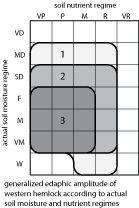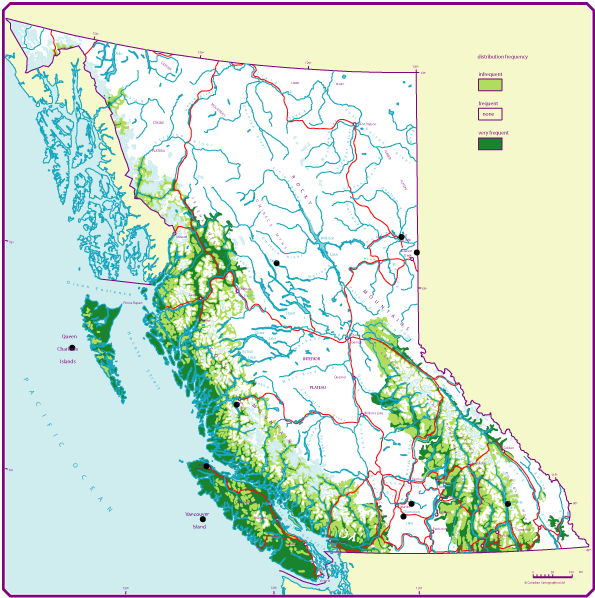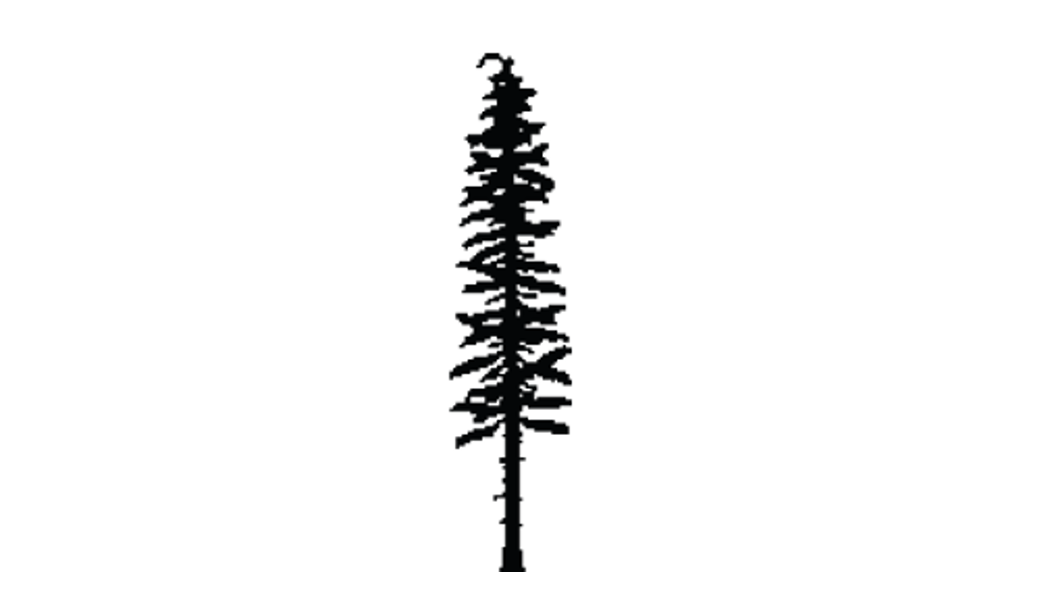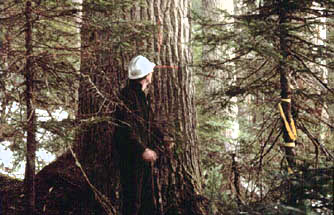Western hemlock
On this page
- Geographic range and ecological amplitudes
- Tolerances and damaging agents
- Silvical characteristics
- Genetics and notes
Geographic range and ecological amplitudes
Description
Western hemlock is one of the most common and important timber species of Pacific North America. It is a medium- to large-sized (nearly to 80m tall), evergreen conifer, at maturity with a narrow upper crown, drooping leader, overall dense, conical crown, long branches, and dark reddish-brown, furrowed bark with flat-topped scaly ridges. The wood of western hemlock is used for both pulp and lumber.
Geographic range
Geographic element:
Western North American/mainly Pacific and less Cordilleran
Distribution in Western North America:
north, central, and south in the Pacific region; central in the Cordilleran region
Ecological Amplitudes
Orographic amplitude
submontane - montane - (subalpine)
Occurrence in biogeoclimatic zones:
(lower MH), (SBS), (IDF), ICH, (CDF), CWH
Edaphic amplitude

Range of soil moisture regimes:
(moderately dry) - slightly dry - fresh - moist - very moist - (wet)
Range of soil nutrient regimes:
very poor - poor - medium - rich; oxylophyte
Western hemlock (as well as common douglas, western redcedar, grand fir, Sitka spruce, and western white pine) is adapted to a long growing season. This is why it grows well in humid mesothermal and subhumid to humid temperate climates. However, in temperate climates much of the precipitation is in the form of snow (25 to 50% compared to <15% in mesothermal climates). It is because of the shorter growing season that western hemlock can grow without as much precipitation as would occur during a longer growing season.
Western hemlock is infrequent in montane boreal or subalpine boreal climates, however, it does occur in the areas adjacent to the ICH, MH and ESSF zones. Its vigor is reduced if repeated frost damage takes place. This frost damage is not easily detectable because damaged western hemlock leaves are shed quickly.
Western hemlock does not tolerate a frozen forest floor in which its rhizosphere is mainly embedded. If the ground is covered by snow before freezing, western hemlock tolerates considerable frost; only the crown above the snow is slightly affected. This is why its distribution is limited to areas where the ground is well-covered by snow before the soil can freeze. Because rhizospheres of common douglas are expanded into the subsoil, frost cannot affect it as easily as it does western hemlock.
Western hemlock tolerates very poor soils. It grows best with a well-balanced supply of nutrients in small quantities and with a continuous supply of water. It commonly regenerates on acid (Mor) forest floors and especially on coniferous decaying wood, which retains high moisture content. Such well-decayed coniferous wood is frequently the only suitable substrate for the successful germination and growth of western hemlock on nutrient rich sites. Fire or any other removal of coarse woody debris may decrease the chance for productive growth of western hemlock.
Because western hemlock regenerates best on acid organic materials, it is probably adapted to a supply of ammonium or amino acids. Experimentally, it has been found that western hemlock easily survives any deficiency treatment better than other conifers, with the exception of mountain hemlock, which reacts in a similar way to Western Hemlock (Brooke et al. 1970). Western hemlock may grow in sand cultures without any supply of nitrates for more than two years. However, when some nitrates are added the growth is improved (Krajina 1969, Krajina et al. 1973).
Tolerances and damaging agents
Root system characteristics
Western hemlock is a shallow-rooting species which does not develop a tap root. The fine roots are nearly entirely confined to the surface organic layer and are associated with both ecto- and endo-mycorrhizae.
| Tolerance to | Tolerance class | Comments |
|---|---|---|
| low light | H | about the same tolerance as Pacific silver fir and western redcedar |
| frost | L | very low in coastal populations, low in interior populations |
| heat | L | protection-requiring on warm and dry sites |
| water deficit | L | protection-requiring on dry and warm sites; higher tolerance than that of Pacific silver fir |
| water surplus | M | on wet sites, it grows usually on mounds |
| nutrient (mainly N) deficiency | H | frequent on very poor sites |
| Damaging agent | Resistance class | Comments |
|---|---|---|
| snow | L - M | low in coastal populations, intermediate in interior populations |
| wind | L | very low resistance to windthrow |
| Risk class | ||
|---|---|---|
| fire | L - H | low in coastal populations, high in interior populations |
| insect | L - H | not a major concern in coastal populations, high in interior populations: western hemlock looper, hemlock sawfly, western blackheaded budworm |
| fungi | M | root and butt rots (for example, Indian paint fungus, annosus root and butt rot, red ring rot, laminated root rot, Armillaria root disease, Schweinitzii butt rot, black stain root disease), Douglas-fir needle cast can be a major concern |
| other agents | H | dwarf mistletoe (Arceuthobium tsugense (Rosendahl) Jones) |
Associated tree species and successional role
In British Columbia, western hemlock grows in pure, even-aged (usually after windthrow or wildfires) or uneven-aged stands or in a variety of mixed-species stands. It is present in early, mid-, and late stages of secondary succession; a major component in old-growth stands in the ICH and CWH zones.
tree species
Genetics and notes
Genetics
Western hemlock frequently hybridizes with mountain hemlock [Tsuga x jeffreyi(Henry) Henry], especially in the ecotone between the CWH and MH zones.
Notes
Western hemlock is an easy species to regenerate. It may be grown in pure stands or, preferably, together with Sitka spruce or western redcedar. Its timber provides all-purpose raw material suitable for construction and pulp. More detailed silvics information is given by:
Packee, E.C. Tsuga heterophylla. Pp. 613-622 in R.M. Burns and B.H. Honkala (technical coordinators) Silvics of North America, Vol. 1. Agri. Handbook 654, USDA For. Serv., Washington, D.C.
Ruth, P.H. and A.S. Harris. (compilers) 1979. Management of western hemlock - Sitka spruce forests for timber production. GTR-PNW-88, USDA For. Serv., Northwest Forest and Range Exp. Station, Portland, Oregon.



